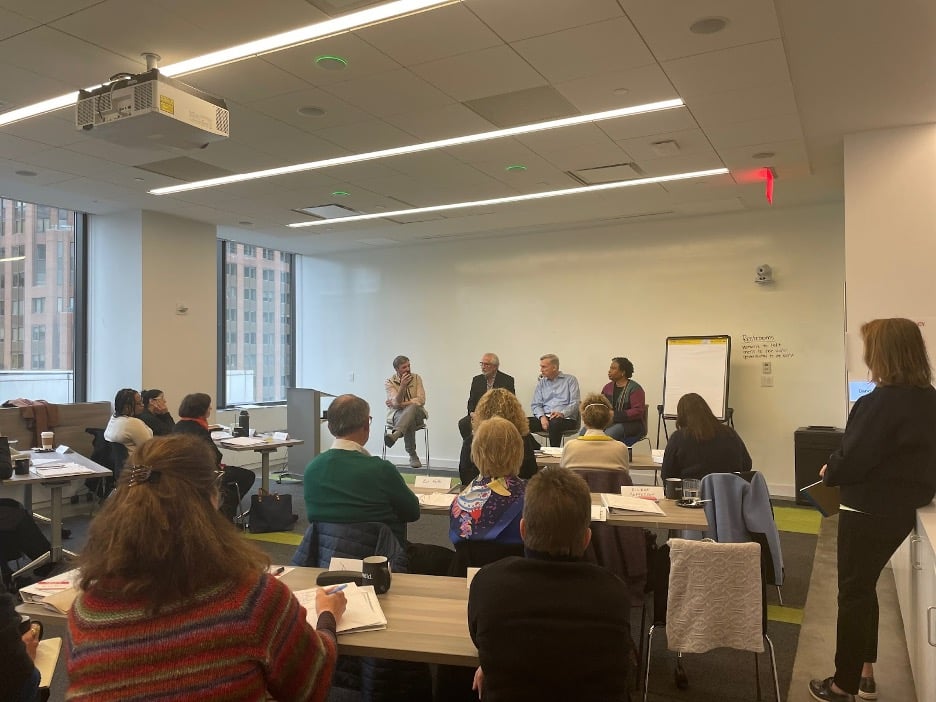“I love being an interim executive so much. It is a really good fit for me, and I hope to do this for a long time to come. As a Black woman, I feel more free as an interim executive to speak up and challenge folks. I’m concerned that our society places extraordinary expectations on permanent executive directors in this sector, and until we change that practice, I prefer to be an interim executive and help smooth the path for others.”
Robin Jenkins (far right) joins Xander Subashi, Ian Benjamin, and Richard Burns (left to right) at a recent interim executive director panel
In the Fall of 2018, Robin Jenkins joined a cohort of social sector leaders to explore the role of the interim executive director. For over 20 years, Support Center has engaged hundreds of leaders who are interested in exploring the role of interim executive director. Recently, Support Center had an opportunity to catch up with Robin after a series of interim executive placements.
Prior to attending the training and beginning a career as an interim executive, Robin was CFOO of The HOPE Program, overseeing the financial merger of two nonprofits and a social enterprise and had overseen a 75% increase in the organization’s annual budget, a 35% growth in staff and 530% increase in government grants.
In 2018, Robin joined roughly two dozen peers to explore the work of an interim executive through a two-day institute which frames and situates interim executive directorship. Each year, Support Center coordinates two to three such institutes that explore the different ways in which interim executive directors help to stabilize organizations through transition. Support Center believes that there are clear differences and boundaries for interim executives, and the training presents those differences through panels, case studies, frameworks, and examples from Support Center’s work with hundreds of organizations in which an interim executive was placed.
Since 2018, Robin has engaged with five different organizations through Support Center including:
- International Women’s Health Coalition which is now a part of Fos Feminista – a feminist alliance representing 170+ organizations worldwide advancing reproductive rights, health, and justice.
- OnPoint NYC advocates for social justice and strives to address adverse outcomes among people who use drugs or engage in sex work (merged entity of New York Harm Reduction and Washington Heights CORNER Project)
- BRIC is a leading arts and media institution anchored in Downtown Brooklyn whose work spans contemporary visual and performing arts, media, and civic action
- United Community Centers in East New York works to address community challenges, celebrate strengths and provide services that improve lives
- Girl Be Heard develops, amplifies, and celebrates the voices of young women through socially conscious theatre-making
What’s clear is that Robin’s leadership and management strengths have already translated across a wide range of organizations from place-based arts organizations to advocacy and social justice to community-based organizations. One of the common principles for Support Center is that interim executive directors bring a broad range of leadership and management skills although they may not necessarily have deep knowledge of a particular issue area.
For her part, Robin talks about the common elements across these interim placements. “I usually enter places where there is trauma,” says Jenkins. Part of Robin’s work as an interim executive involves understanding and naming that trauma. For instance, at one organization there was a public letter from former employees calling attention to racism and discrimination at the organization. Robin was tasked with addressing the concerns as the interim executive while ensuring that the organization would continue to operate. Being open and creative about engaging staff, the board and human resource experts increased the opportunities for all to participate in inclusive spaces.
Robin brings both her prior experience, different perspectives and identifies to stabilize organizations in transition. When asked what helps her to see different perspectives and to be understanding and empathetic to the different challenges that organizations experience, Robin recalls any number of personal experiences. Attending boarding school as well as public school, going to Smith College, living overseas in Zambia, and being in spaces with different people are all a part of what has shaped Robin and her approach to interim leadership. She is not afraid of people with more money and power, and she is grounded in her own history and where she comes from.
And while there are clear differences across her interim executive positions, Robin offers up a few lessons for other interim executives (and to organizations with an interim executive) based upon her experiences:
- Think of the future long-term executive director as a successor that you don’t yet know but are really looking forward to meeting. Listen carefully about the future needs of the organization and consider how as an interim executive you can make the life of that future executive director easier without influencing that selection process.
- Consider where and how you can bring additional resources like financial analysis or Human Resources support to the organization. Where can you find money, resources, and connections to strengthen the organization? In her various positions, Robin has helped to build capacity by identifying and securing additional supports.
- Care for board members and staff who have been traumatized as humans even if they have more power.
- Challenge yourself and others to be open and honest. Can you question the way that you have operated for years and be open to change? That’s an opportunity that interim executives can surface.
- Don’t leave the staff out in the search for the next long-term executive director. Find ways to engage key staff in interviews even if they aren’t a formal part of the selection process.
- Lead with enthusiasm. Interim executives can bring energy, enthusiasm, and a focus on the mission particularly during an uncertain time.
- Listen well. It’s hard to hear when you get in the way too much.
If you’d like a chance to connect with Robin, you can find her here and if you’d like to learn more about Support Center’s transition supports and interim executive offerings, visit us here.

